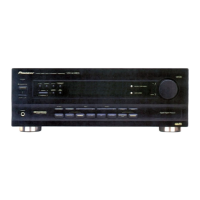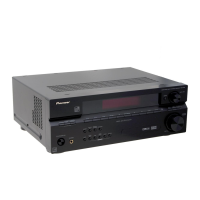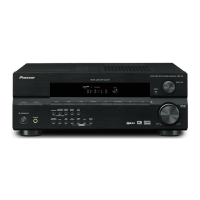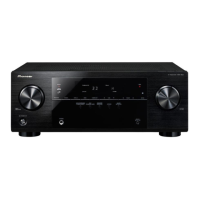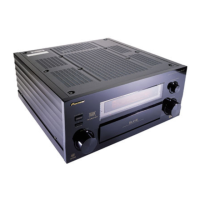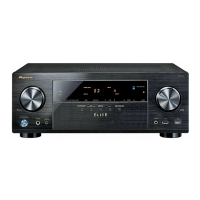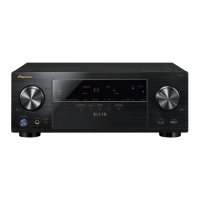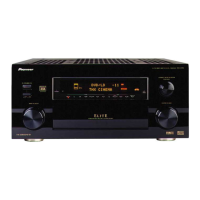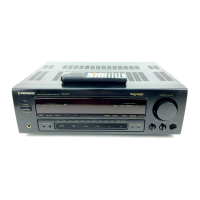
Do you have a question about the Pioneer VSX-403 and is the answer not in the manual?
Describes how to activate and cancel the demonstration mode.
Covers crucial warnings, cautions, and important notices for safe operation.
Explains how this function resets the unit to initial settings.
Covers proper usage, environment, and installation guidelines for safety.
Details precautions for power sources, cords, and plugs.
Outlines cleaning, handling damage, and servicing procedures.
Explains grounding requirements for outdoor antennas.
Explains STUDIO, SIMULATED SURROUND, and DOLBY PRO LOGIC SURROUND modes.
Describes how combining front and rear signals enhances sound field.
Details center channel settings (NORMAL, WIDE, PHANTOM).
Illustrates optimal placement for front, center, and rear speakers.
Explains how to create a simulated stereo effect from mono sources.
Provides instructions for setting up the AM loop antenna.
Warns about potential adverse effects on cassette decks.
Illustrates connections for turntable, CD player, cassette decks, and power amplifier.
Shows how to connect FM and AM antennas.
Illustrates connections for LD player, VCR, and TV monitor.
Explains how to connect speaker cords to terminals.
Details how to connect the center speaker cord.
Guides connecting a super woofer system to speaker terminals.
Explains the power switch, standby indicator, and timer function.
Covers FM/AM, MPX MODE, and CENTER MODE buttons.
Details SIMULATED STEREO, DOLBY 3CH LOGIC, SUPER BASS, and MASTER VOLUME.
Describes input selector buttons and SPEAKERS A/B switches.
Explains STATION CALL, DIRECT ACCESS, and RETURN buttons.
Covers SUPER BASS, BASS, TREBLE, and BALANCE controls.
Details various indicators like MUTING, MEMORY, STEREO, SIMULATED STEREO.
Details FM/AM antenna, PHONO, CD, and GND terminals.
Covers REAR, CENTER SPEAKER, and CENTER AMP PRE OUT connections.
Explains VCR/TAPE 1, VIDEO OUT, CONTROL IN/OUT, AC OUTLET, and AC INLET.
Outlines steps for selecting TUNER, FM/AM, and speakers.
Explains FM auto stereo and monaural reception.
Details how to input frequencies directly using station call buttons.
Describes how to automatically find stations by frequency.
Explains how to tune stations step-by-step.
Details how to store and recall stations using MEMORY and STATION CALL.
Explains how to select preset stations.
Notes that the last received station is recalled on power-up.
Guides on receiving stereo TV sound via FM radio.
Lists input selector buttons for various sources like records, CDs, tapes, VCRs, LDs.
Details how to operate components for playback and adjust volume/tone.
How to record from various sources onto VCR/TAPE 1.
How to record onto Tape 2, including tape monitoring.
Steps for adjusting surround sound levels (center, rear).
How to select surround modes and begin playback.
How to adjust delay time for surround effects.
Recommends special FM antennas for better signal quality.
Explains grounding procedures to reduce FM noise.
Suggests indoor or outdoor antennas for improved AM reception.
Instructions for inserting batteries into the remote control unit.
Explains operating range, angles, and battery replacement.
Explains remote functions for tuning, scanning, and station selection.
Details remote functions for surround modes, volume, muting, and inputs.
Explains remote control functions for CD players.
Details remote control functions for cassette decks.
Explains remote control functions for TVs.
Explains remote control functions for VCRs.
Details remote control functions for LD players.
Addresses issues with power not coming on or control not working.
Solves problems related to no sound or high noise levels.
Covers issues with FM and AM reception.
Solves problems with auto-tuning not stopping and no rear sound.
Addresses remote control malfunction and interference.
Details power output, frequency response, and input/output levels.
Lists FM and AM tuner frequency ranges, sensitivity, and selectivity.
Includes power requirements, dimensions, weight, and included accessories.
Encourages safe listening habits to protect hearing.
Provides a list of decibel levels and their examples.
